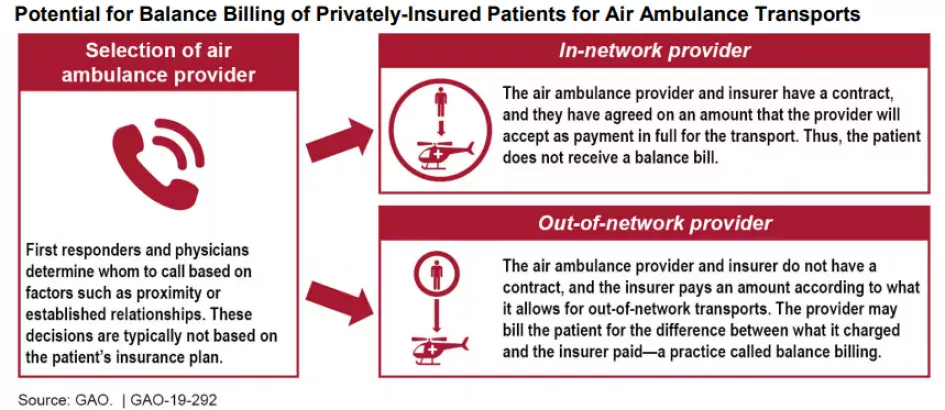The High Cost of a Medical Flight
An air ambulance may save your life in an emergency, but it could cost you thousands of dollars—even if you have health insurance.
In today’s WatchBlog, we look at a recent GAO report on air ambulance services and explore how patients who are airlifted by air ambulance providers that are not part of their insurance networks could face substantial financial risk.
Patients generally have no choice in who picks them up
In a life-threatening situation, such as a car accident, an air ambulance can quickly get you to a hospital.
However, in such emergencies, you generally can’t choose which air ambulance provider picks you up, which means the provider that gives you a lift may not be in your insurer’s network.
Patients with insurance may not be protected
Air ambulance transports can be expensive. We found that the median charge for a helicopter air ambulance ride was about $36,000 in 2017.
When a patient is transported by a provider that is part of his or her network, health insurance usually pays for part of the bill, and the patient pays an additional portion through a copay or coinsurance. However, out-of-network providers may send the patient a bill for the difference between what it charged and the insurer paid. This is known as balance billing, or surprise medical billing.
Providers are prohibited from sending balance bills to patients with federal insurance (e.g., Medicare, Medicaid). However, those with private health insurance may receive them if the provider is out-of-network.
We found that 69% of the privately insured air ambulance transports in the data we reviewed for 2017 were out of the patient’s insurance network (Note: This sentence was edited on 4/3/19 to specify the transports were privately insured). However, not all patients with out-of-network transports receive balance bills, and the data do not show the extent to which this occurred.
What can you do if this happens to you?
If you receive a balance bill for an air ambulance transport, here are some possible options:
- The Department of Transportation has information on its website on how to submit an air ambulance complaint (a feature the agency added in response to one of our previous recommendations).
- You may also be able to file a complaint with your state’s insurance department. We reviewed 60 complaints that patients filed with 2 states, and all but 1 complaint were for a balance bills in the tens of thousands of dollars.
- You can also appeal the balance bill to your insurer or to the provider. Providers may agree to reduce the amount you owe, or insurers may increase the payment to the provider.
To learn more, check out our report.
- Comments on GAO’s WatchBlog? Contact blog@gao.gov.
GAO Contacts
Related Products

GAO's mission is to provide Congress with fact-based, nonpartisan information that can help improve federal government performance and ensure accountability for the benefit of the American people. GAO launched its WatchBlog in January, 2014, as part of its continuing effort to reach its audiences—Congress and the American people—where they are currently looking for information.
The blog format allows GAO to provide a little more context about its work than it can offer on its other social media platforms. Posts will tie GAO work to current events and the news; show how GAO’s work is affecting agencies or legislation; highlight reports, testimonies, and issue areas where GAO does work; and provide information about GAO itself, among other things.
Please send any feedback on GAO's WatchBlog to blog@gao.gov.








